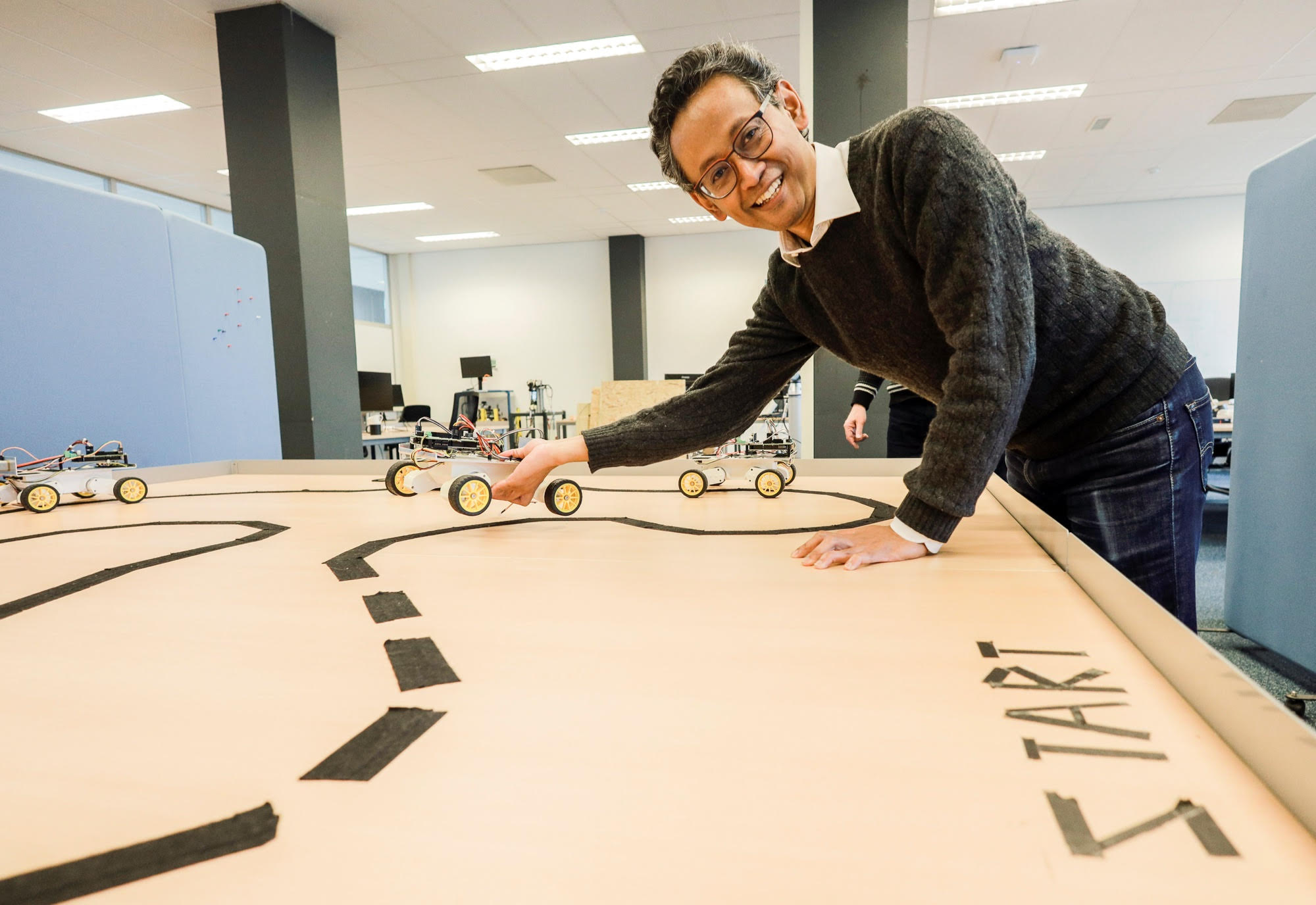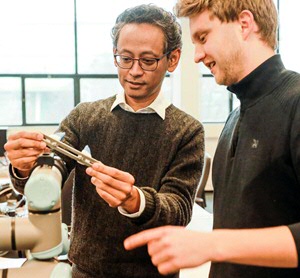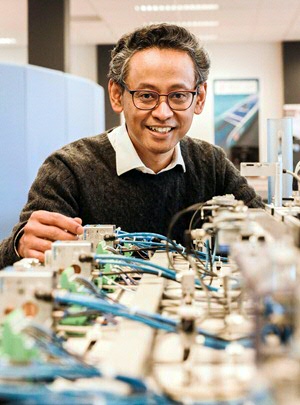Bayu Jayawardhana is a pioneer in the world of control technology
One moment he contributes to the development of a scientific instrument for an extremely large telescope, the next he is working on generating energy from the ocean: Bayu Jayawardhana moves effortlessly through the world of mechatronics and nonlinear control technology. He is a true pioneer in his field. What has he discovered so far? And how does he keep track of everything? And where can we see the applications?
Text: Thomas Vos, Corporate Communication / Photos: Henk Veenstra
Jayawardhana is a big name in mechatronics and nonlinear control technology. One project he has worked on is the Ocean Grazer, a project that comprises the storage of energy under water and a system to generate energy using the heaving motion of ocean waves. For this work, he and his colleagues won the Ben Feringa Impact Award. They also reached the finals of the Huibregtsen Prize with this project. Jayawardhana has also developed components for the Extremely Large Telescope in Chile. In addition, he directs various institutes and alliances, including the Engineering and Technology Institute Groningen (ENTEG) and, since recently, also the Dutch Institute for Systems and Control (DISC), of which he is the scientific director. Lastly, he was the first programme director of the Master’s degree programme in Mechanical Engineering at the University of Groningen.

Top university for control technology
In 2008, after working at a few British universities, Jayawardhana came to Groningen: ‘I have always wanted to have a career in science. The University of Groningen is the most important university in the Netherlands in the field of systems and control, my field of discipline. A number of groundbreaking research results come from this University and that is known worldwide. When the position became available in 2007, I made the most of the opportunity. Time has flown by since.’
Mechatronics and nonlinear control technology
From the beginning, Jayawardhana worked on mechatronics and nonlinear control technology. Mechatronics is a technological discipline in which electrical engineering, mechanical engineering, and systems and control engineering come together. Examples of technologies that originate in mechatronics include, for example, the CD player and climate control systems. Jayawardhana explains nonlinear control technology as follows: ‘Imagine you want to cycle to the pub. In that case, your brain is the controller that ensures that you are able to maintain the cycle upright. We express and develop such controllers using mathematical formulas and artificial intelligence (AI). Controllers act as the brain in mechatronics.’ A well-known example of an everyday application is the thermostat.
Extremely Large Telescope
Once in Groningen, Jayawardhana was able to start immediately on a project of SRON Netherlands Institute for Space Research. SRON is involved in the development of METIS, a scientific instrument that is part of the Extremely Large Telescope, a European megatelescope in Chile. Jayawardhana: ‘The instrument uses an optomechatronic mirror system that can be used to take precise measurements. This mirror ensures that the image of, for example, a star is clear by correcting the distorted wavefront that is formed between the star and the telescope. Together with a PhD student, I picked up the development of the mirror and, in 2014, we were able to deliver a usable technique that is now part of METIS.’
Applications

The project with the optomechatronic mirror system has not finished yet; another of Jayawardhana’s PhD students is working every day on innovative deformable mirrors, together with SRON and high-tech company ASML, which envisions possibilities for practical applications in high-tech industry. Jayawardhana is also involved in various other projects, including Digital Twin, funded by the NWO (Dutch Research Council). Jayawardhana: ‘As part of this project, we are studying how we can combine AI with modern, model-based engineering methods, such as control technology. For example, if we want to develop new control technology, we can use AI to deal with the complexity and uncertainties in the model. It may then not be very accurate, like ChatGPT, but it will provide a strong foundation. In the past, we had to make such an accurate model ourselves, which costs a lot of time and money.’
Agricultural robot
That foundation will be applied shortly in an agricultural robot project, together with TNO (Netherlands Organization for Applied Scientific Research), Hanze, NHL Stenden, and Saxion universities of applied sciences, and regional companies that develop autonomous robots for agriculture and horticulture. Jayawardhana: ‘Within our Faculty, we are currently working on two new engineering degree programmes: Autonomous Systems and Sustainable Process Design. These will ensure that new knowledge from our scientists and engineers has a direct impact on innovations and processes in industry.’
Safety
Safety is always the priority, emphasizes Jayawardhana: ‘We are always working with theories, with mathematical proof. We must be able to demonstrate that the combination of control technology and AI will not be detrimental to the safety of the entire system. Within limits, small differences are allowed, approximation errors, small deviations that will not be at the expense of the system. However, we really must stay within those limits.’
Searching for Earth 2.0

Something that Jayawardhana thinks has a lot of future potential is the further development of deformable mirrors: ‘They are presently still in the lab, but they will have an impact in the future. The mirrors make it possible to realize high-contrast optical systems. That is extremely necessary to study exoplanets adequately. Astronomers, for example, want to know the composition of those planets and can find out based on measurable photons, spectra of light. However, the light from exoplanets is often dim. The star that the exoplanet orbits is often much brighter. So, if we want to find Earth 2.0, it is going to be difficult. The deformable mirrors must make it possible to still obtain good images.’
Reliable product
The intended applications make further development of the mirrors a challenge. Jayawardhana: ‘It is the intention that the mirrors become a component of a telescope that will be launched into space. When that happens, you suddenly have to also meet various other requirements. For example, there will be extreme vibrations upon launching and the mirrors must be able to cope with that. Therefore, we must deliver a truly reliable product and that is what we are currently trying to develop.’
Ocean energy
From the cosmos to the ocean: Meanwhile, Jayawardhana also continues working on the Ocean Grazer, a project that makes it possible to endlessly generate energy from the movement of waves. Jayawardhana: ‘The Ocean Grazer is presently a startup, aimed at energy storage, like a type of battery under water at, for example, offshore wind turbines. At the same time, we are still working hard on the technology to generate energy from waves, the wave energy converter. That cannot be applied commercially yet, in contrast to the battery, but it offers many opportunities.’
Wonder
Jayawardhana recognizes that he is working on many projects: ‘I am not sure that I should talk about all of them, haha.’ Is there something that stands out? ‘I have a passion for all my projects. Technology keeps surprising me and I am very happy to be a part of that. But it is difficult to keep up with everything. That is why we must have a good team. We keep each other on our toes as far as control technology goes, even if we are working on different applications.’
| Last modified: | 29 February 2024 1.15 p.m. |
More news
-
13 May 2024
‘The colourful cells of petals never get boring!’
Most people will enjoy colours in nature. However, the interest of evolutionary biologist Casper van der Kooi goes much further: he studies how flowers, birds, butterflies, and beetles get their colours. He also studies how these colours are used...
-
13 May 2024
Trapping molecules
In his laboratory, physicist Steven Hoekstra is building an experimental set-up made of two parts: one that produces barium fluoride molecules, and a second part that traps the molecules and brings them to an almost complete standstill so they can...
-
07 May 2024
Lecture with soon to be Honorary Doctor Gerrit Hiemstra on May 24
In celebration of his honorary doctorate, FSE has invited Hiemstra to give a lecture entitled ‘Science, let's talk about it’ on the morning of 24 May
